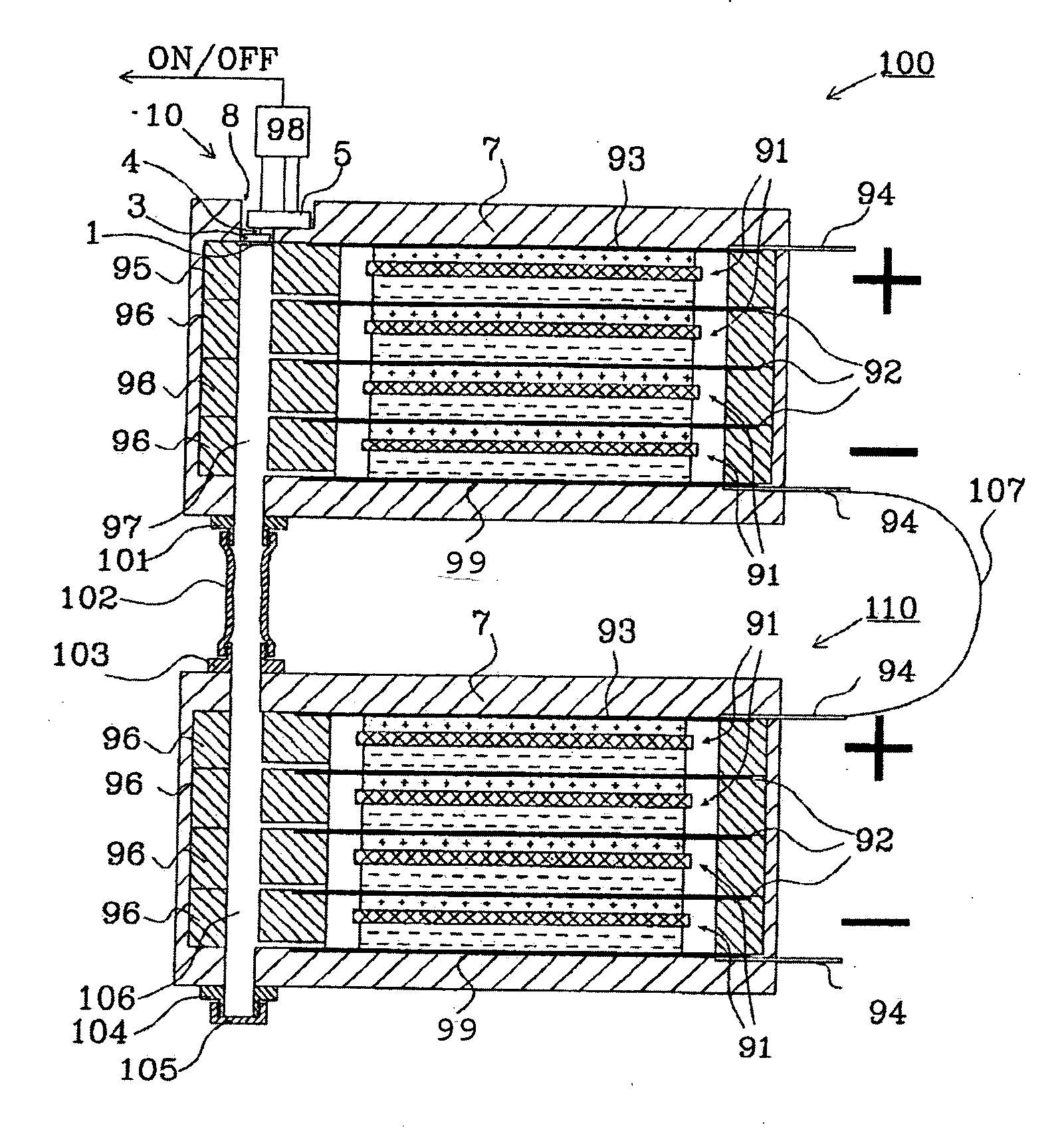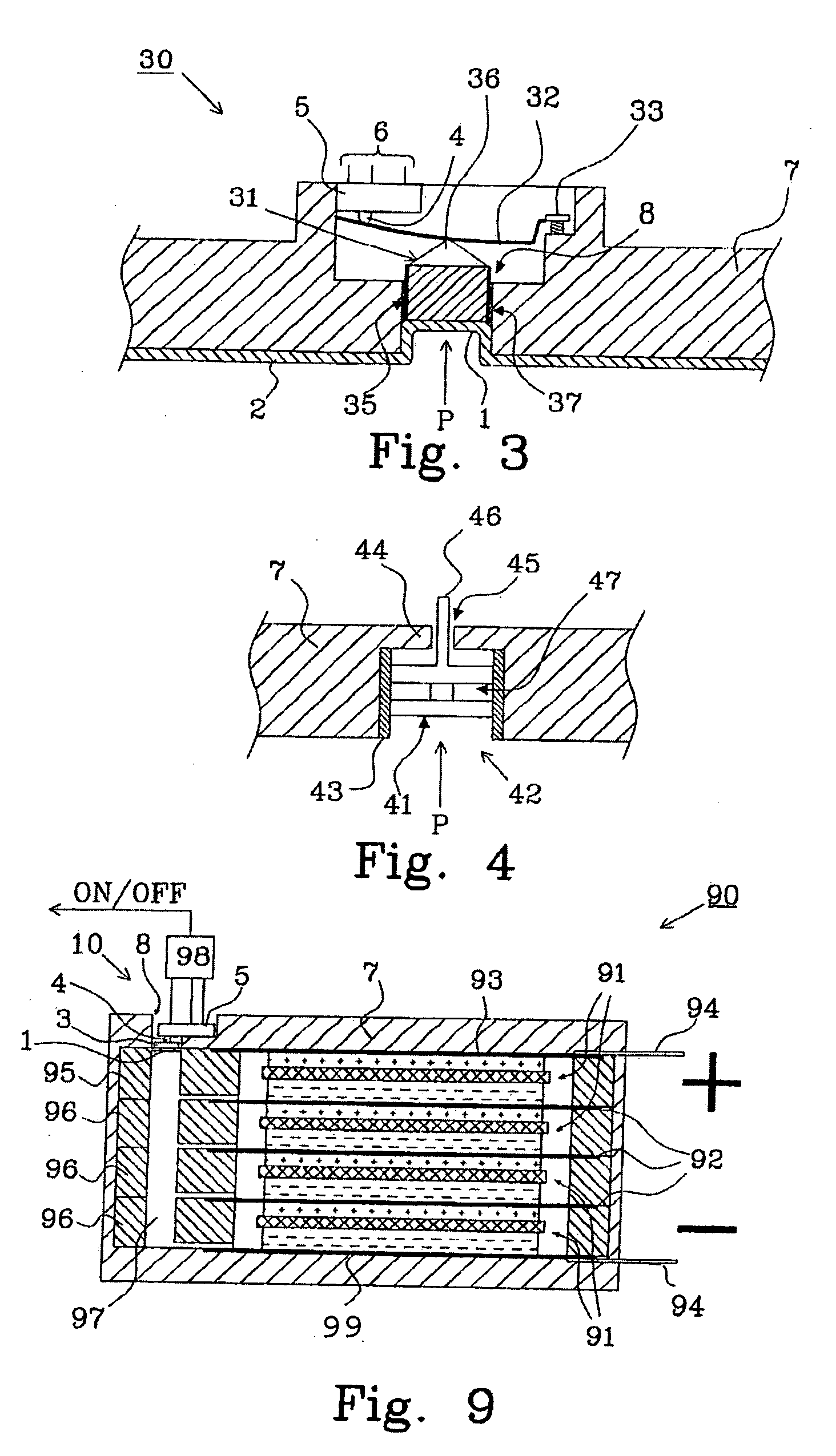Bipolar battery including a pressure sensor
a battery and pressure sensor technology, applied in the field of bipolar batteries, can solve the problems of high corrosion inside the battery, high cost of sensors that will endure the environment, and sensors that cannot adapt to the environment, so as to reduce the influence of the mechanism on the precise pressure, reduce the spring constant, and tighten the effect of elastic properties
- Summary
- Abstract
- Description
- Claims
- Application Information
AI Technical Summary
Benefits of technology
Problems solved by technology
Method used
Image
Examples
third embodiment
[0035]FIG. 3 shows a pressure sensor 30 provided with an adjustable spring arrangement. A pressure P from inside the battery cell is transformed into a reciprocal movement of the membrane 1, being a part of the hydrophobic barrier 2, as described in connection with FIG. 1. The membrane 1 acts as a balloon when the pressure P is applied from the inside due to the elasticity of the membrane 1. A moving item 31, hereafter called actuator, is placed inside the opening 8 of the housing 7, and on top of the membrane 1 opposite to the corrosive side of the membrane 1.
[0036]The adjustable spring arrangement, which is a pressure control means, comprises a spring 32 and a setting screw 33. The actuator 31 will affect the spring 32, and the spring constant can be set by adjusting a setting screw 33. The spring 32 is supported by the housing 7. A pressure increase will then affect the shape of the spring 32, that eventually will affect the contact 4 on the switch 5 and either short circuit the ...
fourth embodiment
[0041]FIG. 5 shows a pressure sensor 50 comprising a lever mechanism to make it more sensitive for a change in internal pressure P. A membrane 1 in the shape of a sealed bellow, said membrane being a part of the hydrophobic barrier 2, is provided into an opening 8. An actuator 48 is provided between the membrane 1 and the spring 32. A lever mechanism in the shape of a lever 51 with a protrusion 52 is provided, said protrusion being in contact with said spring and one end of the lever 51 being supported by the housing 7. The contact 4 of the switch 5 is in contact with a second end of the lever 51.
fifth embodiment
[0042]FIG. 8 shows a pressure sensor 80 comprising a bellows, bladder, or balloon structure, 81 formed in a gas tight outer seal 82, such as a membrane made from a hydrophobic barrier. A strain gauge 83, such as a piezo resistive MPX pressure sensor silicon device available from Freescale Semiconductor, is provided on top of, and in contact with, the bellows 81. Wires 85 are provided from the strain gauge through a casing, wherein the strain gauge 83 is pressed against the casing 7 when an internal pressure P increases. The stress / strain characteristics of the material of the strain gauge is known and well defined from the manufacturer, and an analogue signal is available at the wires 6 that indicate the amount of contact pressure on the strain gauge 83. Preferably, the bellows 81 in the membrane 82 has a much smaller spring constant and larger mechanical compliance than the material in the strain gauge 83, so dependence of the strain gauge signal on the bellows 81 is reduced to be ...
PUM
 Login to View More
Login to View More Abstract
Description
Claims
Application Information
 Login to View More
Login to View More - R&D
- Intellectual Property
- Life Sciences
- Materials
- Tech Scout
- Unparalleled Data Quality
- Higher Quality Content
- 60% Fewer Hallucinations
Browse by: Latest US Patents, China's latest patents, Technical Efficacy Thesaurus, Application Domain, Technology Topic, Popular Technical Reports.
© 2025 PatSnap. All rights reserved.Legal|Privacy policy|Modern Slavery Act Transparency Statement|Sitemap|About US| Contact US: help@patsnap.com



